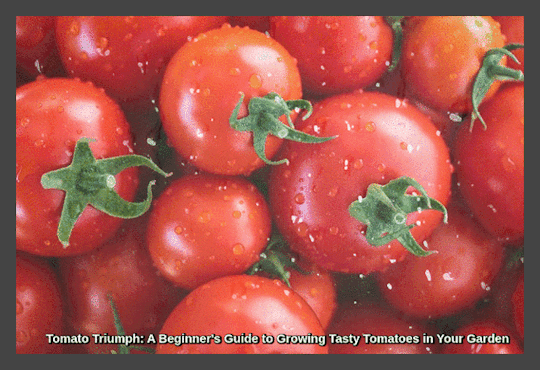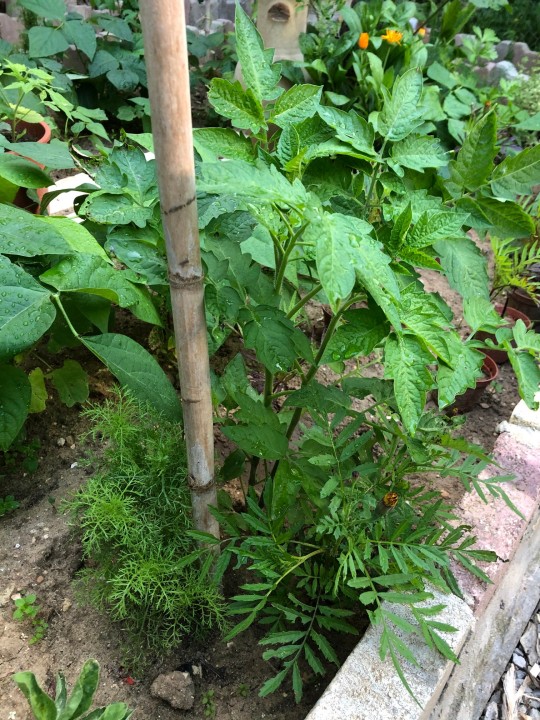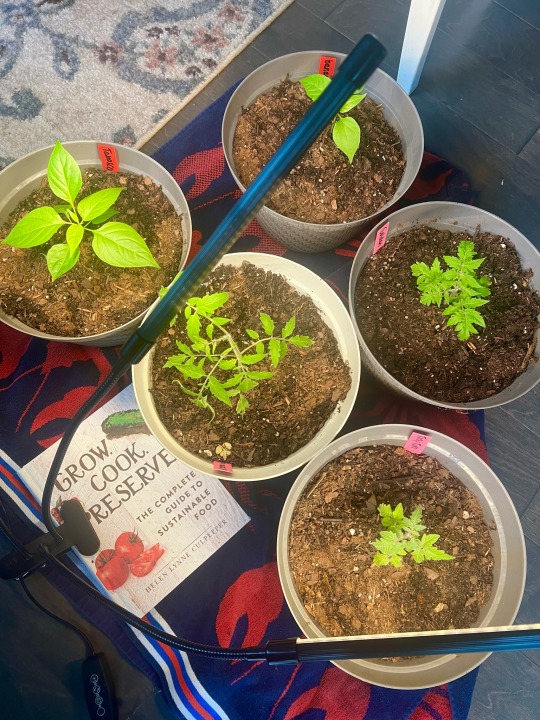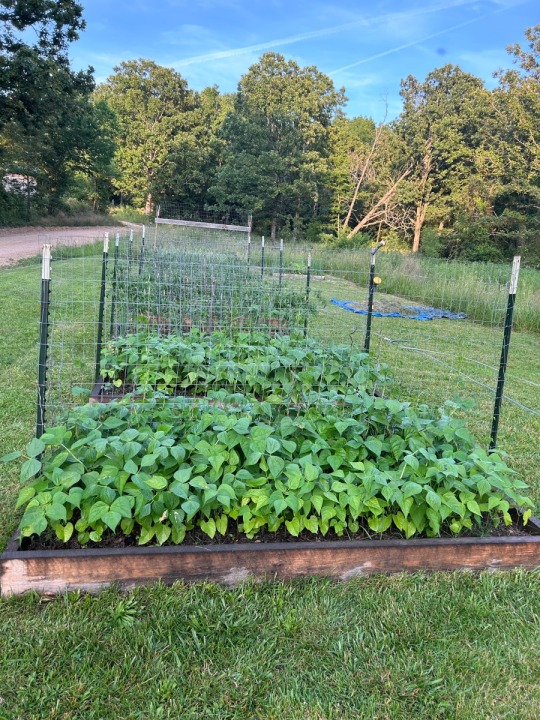#Growing Tomatoes
Explore tagged Tumblr posts
Text
Oh snap! I just planted the first seeds of 2025! Its indoor seed sowing time over here!
I know it's a bit early, but gardening makes me so happy, and after the last few gut-wrenching days, I just needed to play in the dirt right now.


I dusted off the old aerogarden, used some generic soil cones, and stuffed them with dollar store seeds left over from last year.
I planted beefsteak toms, cherry toms, and jalapeno in the aerogarden.
After that, I planted green onions in a ceramic bread pan that I never baked in because it was too pretty. I filled it with the last of '24's garden soil.
Here's to the hope that spring will be swift and sweet.
#urban gardening#gardeners on tumblr#container gardening#urban farming#green thumb#self sustainability#gardenblr#gardencore#growing stuff#urban cottagecore#diy#touch dirt#growing tomatoes#jalapeños#reduce reuse recycle#budget diva
21 notes
·
View notes
Text
Growing Tip: Marmande Tomatoes

After sucessfully growing Cherry Tomatoes this past couple of years, I've become more ambitious this year and decided to grow bigger tomatoes! Not any bigger tomatoes either, but Marmande Tomatoes, these big, tasty, juicy Beefsteak heritage tomatoes, proudly displayed on many a Provençal market stall!
I sowed my Marmande tomato (Solanum lycopersicum) seedlings, a generous sprinkle over a mixture of good potting soil and a handful of compost in a flat-ish but wide enough pot on the 18th April. I covered the seeds with a light sprinkle of the same mixture, watered, dusted with grated coal to prevent damping off and took the pot upstairs, to the Nursery, just under the window with plenty of light, warmth and regular waterings.
A few days later, they were already sprouting. Quickly, the seedlings started growing proper leaves after their dicot cotyledon. As they grew, I thinned them, pinching off the weaker seedlings so the others had more room to expand.
On the 7th May, I potted two or three seedlings in small pots, filled with garden soil, potting soil and a handful of compost. Watered well and took them back up to the Nursery.
I continued tending to them, much like I did the Garden Cherry Tomatoes, until they started growing proper leaves, and sturdier stalks and reached about 12 centimetres/4.75 inches. I potted these in large pots in the garden filled with a mixture of garden soil, potting soil and a handful of compost a month later.

In late July, the seedlings had grown nicely and started blooming. I used sturdy branches I had cut from the apple and pear trees in the Wintrer to stake them, as they would be heftier once the tomatoes started growing.

And once the flowers were pollinated, it did not take long before tiny tomatoes indeed started growing!

And then, they just kept growing!


And began ripening!

Until I harvested my first Marmande Tomato on! And it was as fragrant and juicy and tasty as a gardener humbly wishes! Simply delicious.
I harvested three more today, and a couple are still ripening on the vine. They might have gotten a bit bigger, but there was plenty of rain by the end of the Summer! And now I know I shall sow them a little earlier next year.
For now, I am thoroughly enjoying these beautiful heritage gems!
#Growing and Gardening#Growing#Growing Tip#Growing Tips#Growing Tomatoes#Garden Tomatoes#Marmande#Marmande Tomatoes#Beefsteak Tomatoes#Heritage Tomatoes#Growing Vegetables#Growing Veges#Vegetables#(Yes; I know Tomatoes are fruit!)#Kitchen Garden#Back Yard#Garden#Gardening#Gardening Tip#Gardening Tips#Growing Food
7 notes
·
View notes
Video
youtube
🌻 Savoring the Fruits of Labor 🍅: After months of care and attention, the moment of truth has arrived! 🌟 In this video, we’ll share the joy and satisfaction of harvesting and tasting our homegrown organic Plum Cherry Tomatoes. Follow along as we pick these vibrant fruits, savor the incredible flavor, and reflect on the hard work that made it all possible. Experience the pride of growing your own food, free from harmful chemicals and pesticides, and discover why nothing beats the taste of homegrown tomatoes. Looking forward to the next growing season?
#youtube#youtube video#youtube views#video#videos#growing tomatoes#growing tomatos#tomato#tomatoes#harvesting#vegetable garden#vegetable gardening#vegetables#growing vegetables#my video#my videos#gardenblr#gardencore#gardeners on tumblr#garden#gardens#gardeners
7 notes
·
View notes
Text

7/10/24 ~ Grafted Brandywine update. Gonna be real upset if a hornworm ends up getting this one 🐛
#container tomatoes#tomato farming#growing tomatoes#heirloom plants#heirloom tomatoes#grafting tomatoes#grafting plants#indoor garden#sustainable gardening#container gardening#vegetable gardening#starting seeds#growing food#plant life#plant mom#homesteading
9 notes
·
View notes
Text


Tomato Progress. 🍅 (19 Sep 2024)
Only 2 survived from the initial 4 seeds, but they’re already starting to grow true leaves.
4 notes
·
View notes
Text
Tomato Triumph: A Beginner's Guide To Growing Tasty Tomatoes In Your Garden

Are you ready to embark on a green adventure in your backyard? Growing your own tomatoes is not only a rewarding experience but also an exciting journey into the world of gardening. Whether you're a complete novice or a seasoned green thumb, this step-by-step guide will help you cultivate delicious tomatoes right in your own garden.
Getting Started
Choosing the Right Tomato Varieties
Before you dive into the world of tomato growing, it's essential to pick the right varieties for your garden. As a beginner, start with easy-to-grow options like cherry tomatoes, Roma, or Early Girl. These varieties are robust and forgiving, making them perfect for first-time gardeners.
Picking the Perfect Spot
Tomatoes love sunlight, so choose a spot in your garden that receives at least 6-8 hours of direct sunlight each day. Ensure that the soil is well-draining and rich in nutrients. If your soil needs a boost, consider adding compost to create a tomato-friendly environment.
Planting Your Tomato Seeds
Timing Matters
Timing is everything in the world of gardening. Plan to plant your tomato seeds indoors 6-8 weeks before the last expected frost in your area. This gives your little tomato seeds a head start before transplanting them outdoors.
Planting Depth
When planting your tomato seeds, follow the rule of thumb: bury them twice as deep as their size. This helps the young plants develop strong roots. Use seed trays or small pots filled with seed-starting mix for the best results.
Transplanting Seedlings
Outdoor Transition
Once your tomato seedlings are about 6-8 inches tall and have a couple of sets of true leaves, they are ready to move outdoors. Choose a mild, overcast day for transplanting to reduce stress on the young plants.
Proper Spacing
Give your tomato plants enough room to spread their roots and grow. Plant them at least 2 feet apart to ensure good air circulation, which helps prevent diseases.
Caring for Your Tomato Plants
Watering Wisely
Tomatoes like their soil consistently moist but not waterlogged. Water them at the base to keep the leaves dry, reducing the risk of fungal diseases. Aim for about 1-2 inches of water per week, adjusting based on weather conditions.
Fertilizing Tips
Feed your tomato plants with a balanced fertilizer once a month to keep them well-nourished. Avoid over-fertilizing, as it can lead to excessive foliage growth at the expense of fruit production.
Staking for Support
As your tomato plants grow, they might need a little support to keep them upright. Use stakes or tomato cages to prevent sprawling and ensure proper airflow around the plants.
Harvesting the Fruits of Your Labor
Knowing When to Pick
The most exciting part of growing tomatoes is, of course, harvesting them! Wait until the tomatoes are fully colored and slightly soft to the touch before plucking them. This ensures optimal flavor and sweetness.
Enjoy the Fruits of Your Labor
Congratulations! You've successfully grown your own tomatoes. Whether you slice them for a fresh salad, blend them into a savory sauce, or enjoy them straight from the vine, the taste of homegrown tomatoes is unbeatable.
Troubleshooting Tips
Dealing with Common Issues
No garden journey is without its challenges. Keep an eye out for common tomato problems like pests, diseases, or nutrient deficiencies. A proactive approach to addressing issues will keep your tomato plants healthy and thriving.
Conclusion
Growing tomatoes is a delightful and gratifying experience that anyone can enjoy. With a bit of patience, care, and a touch of green magic, you'll soon be savoring the fruits of your labor. So, roll up your sleeves, put on your gardening gloves, and let the tomato-growing adventure begin! Happy gardening!
#tomatoes#tomato farming#tomato gardening#growing tomatoes#how to#tips#beginner guide#beginner gardening#gardening#homegrown#vegetables#homegrown vegetables#garden#planting#plants#horticulture#botany#organic#easy#easy-to-grow#backyard#diy projects#diy#seeds#fresh#soil#farming#agriculture#green thumb#nutrient rich
3 notes
·
View notes
Text
MY BABIES 🥰
ok so, last week I had a sandwich with tomato. I pulled some seeds out of the tomato, and put them in a wet paper towel.
yesterday, I had noticed that they sprouted

There are five seeds there, sadly the fifth hasn’t sprouted, and I think it’s too small to do anything, which is sad but it’s true that sometimes you just gotta let things die
TODAY: I moved them to some dirt

Since I’m growing them ‘out of season’ I’ve decided to NOT put them outside, so that they’ll be able to grow more easily.
my sister says I’ve over-watered them, but I read that tomatoes like water, so I’ve given them quite a bit. I now fear that I’ve over watered them. I hope I didn’t.
the container they are in is quite short but they’re only going to be in there for a AT MOST 3-4 weeks, so I think it’ll be fine.
the table that they are on is also short, short enough for boxers to put their nose on the table to sniff around, but I think they won’t eat my tomatoes. If they do, I would be very very sad.
#tomatoes#tomato seedlings#growing tomatoes#this is what I am doing with my life#I failed freshman year#but I’m growing tomatoes so it’s all good#growing food
3 notes
·
View notes
Text
Sure! Here's an improved version of the blog post headline: **A Step-by-Step Guide to Planting Tomatoes for a Healthy Harvest** This version is more specific and engaging, suggesting both instruction and a positive outcome. Let me know if you'd like variations with different tones (e.g., casual, expert, playful).

Welcome to the wonderful world of growing your own tomatoes! Nothing compares to the satisfaction of biting into a juicy, sun-ripened tomato you've grown yourself. This article will provide you with detailed insights on how to plant tomatoes, making it easier for anyone looking to start their journey in growing these luscious, versatile fruits. Packed with tips and techniques, we'll guide you through from sowing the seeds to harvest time. Whether you've got a sprawling backyard or a compact balcony space, we'll provide you with the knowledge you need to grow the tastiest tomatoes. So, let's embark on this exciting journey to transform your garden with the cheerful charm of tomatoes.
How Do You Plant Tomatoes? (Without Losing Your Mind or Your Harvest)
Let me confess something: the first tomato plant I ever grew was a hot mess. Literally. It grew sideways, got scorched by the sun, and produced exactly one tomato that tasted like wet cardboard. But after a few seasons of trial, error, and a little talking to the plants (don't judge), I figured out how to grow tomatoes that make my neighbors question their life choices.
So how do you actually plant tomatoes—and not just grow them, but grow them well? It's not rocket science, but it is botanical strategy. Here's what has worked for me, consistently, with cherry, Roma, and even that one heirloom variety I can never pronounce.
1. Choose Your Tomato Wisely
Not all tomatoes are created equal. There are indeterminates (wild, viny, produce-until-the-first-frost types) and determinates (bushier, more civilized, fruit all at once). Pick what suits your lifestyle—and your patience level.
2. Location Isn’t Everything... But It’s Close
Tomatoes crave full sun—6 to 8 hours is the sweet spot. They'll sulk in the shade and mock your effort. Trust me, I learned that after planting mine next to a fence that cast the kind of shadow usually reserved for dramatic films.
3. Plant Deep. Like, Really Deep
Here's the trick no one told me at first: you bury the stem. Yes, bury it deep enough that only the top 4 to 6 leaves are exposed. Why? Because:
Tomato stems grow roots when buried. More roots = stronger plant = more tomatoes. It’s not magic. It’s horticultural physics.
4. Give Them Space to Breathe
Don’t crowd your tomatoes. Each plant needs 18 to 24 inches of elbow room—or leaf room, as they say in the tomato world (okay, no one says that). Crowded plants get moldy, angry, and passive-aggressive with their fruit production.
5. Cage, Stake, or Trellis? Pick Your Tomato Politics
Personally, I’m a fan of the cage. It’s simple, supportive, and lets the plant be its wild self within bounds. But I’ve met gardeners who swear by staking—each to their own vine.
6. Water Deep, Not Daily
Tomatoes like consistency. Give them a deep watering a couple times a week instead of a daily sprinkle. Think of it like a good therapy session: infrequent but profound.
7. Mulch Like You Mean It
I learned the hard way that mulch isn't optional. It keeps the soil moist, the weeds out, and the roots cool. Plus, it gives your tomato bed a polished, Instagram-ready look (if you're into that).
And Finally, Patience (and Pruning)
Treat tomatoes like teenagers: they need guidance, support, and the occasional tough love. Prune the suckers (the little shoots between branches) to help the plant focus on fruit, not foliage. But don't obsess—remember, you're growing dinner, not entering a pageant.
Curious what to do with your tomato bounty once it starts rolling in? I wrote a piece on “What to Do With Too Many Tomatoes”—because let’s be honest, that’s a problem you actually want.
So go forth, plant deeply, water wisely, and prepare for the most satisfying BLT of your life. Or bruschetta. Or tomato jam. Okay, I’m hungry now.
Learn more about gardening with Taim.io!
0 notes
Text
Growing Your Own Legacy: Why Heirloom Seeds Are a Must for Every Gardener
In the world of gardening, there’s something incredibly special about heirloom seeds. These time-honored varieties aren’t just plants—they’re living pieces of history, passed down through generations of gardeners.
If you’ve been looking for a way to make your garden unique, sustainable, and full of flavor, heirloom seeds are the perfect place to start. Let’s dive into why heirloom gardening is more than just a trend and how you can benefit from growing these cherished varieties.
What Exactly Are Heirloom Seeds?
Heirloom seeds come from open-pollinated plants that have been cultivated for decades, often over a century, without genetic modification or hybridization. This means that the plants grown from heirloom seeds are true to type, preserving their original characteristics, from taste to appearance.
These seeds are often treasured within families and communities, with stories and traditions attached to them.
Unlike hybrid or genetically modified seeds, which are bred for traits like uniformity and shelf-life, heirlooms are all about flavor, variety, and sustainability.

Why Grow Heirloom Vegetables?
1. Unrivaled Flavor: One of the biggest draws of heirloom gardening is the flavor.
Because heirloom vegetables haven’t been altered for mass production, they retain their natural, rich flavors.
From juicy tomatoes to crisp beans, heirlooms offer taste profiles you won’t find in typical grocery store produce.
2. Diverse and Unique Varieties: Heirlooms come in an incredible range of colors, shapes, and sizes.
You can grow purple carrots, striped tomatoes, or vibrant yellow cucumbers—bringing both visual and culinary excitement to your kitchen.
3. Sustainability and Seed Saving: Heirloom gardening is a sustainable practice.
Since these plants are open-pollinated, you can save seeds from your best crops and replant them year after year. This not only saves money but also allows you to create a self-sustaining garden.
4. Preserving History and Heritage: Each heirloom seed has a story.
Many varieties have been passed down for generations, making them a living link to our agricultural past.
By growing heirlooms, you help preserve these varieties and ensure they aren’t lost to history.
5. Better Adaptability: Heirloom plants have often been cultivated to thrive in specific regions and climates.
This means they’re more likely to be resilient in local conditions, making your gardening efforts more successful.
Top Heirloom Vegetables to Try in Your Garden
If you’re ready to explore heirloom gardening, here are some standout varieties to consider:
- Black Krim Tomatoes: With a rich, smoky flavor and deep purple hue, Black Krim tomatoes are a favorite for gardeners looking for something truly unique.
- French Breakfast Radishes: These crunchy, mildly peppery radishes are perfect for salads or snacking and grow quickly in most gardens.
- Purple Cherokee Tomatoes: Known for their rich, complex flavor, these tomatoes are ideal for slicing and adding a gourmet touch to any meal.

- Dragon’s Tongue Beans: These stunning beans feature purple streaks and offer a tender, juicy bite.
- Golden Bantam Corn: A sweet, tender heirloom corn variety that’s perfect for grilling or fresh off the cob.
Best Places to Buy Heirloom Seeds
When starting your heirloom garden, it’s essential to source your seeds from reputable suppliers. Here are some of the best places to find high-quality heirloom seeds:
- Baker Creek Heirloom Seeds – Known for a huge selection of rare and unique heirloom varieties from around the world.
- Seed Savers Exchange – A nonprofit organization focused on preserving heirloom varieties through seed sharing and education.
- Renee’s Garden – Specializes in gourmet and heirloom varieties that are perfect for home gardeners.
- High Mowing Organic Seeds – Offers a large selection of organic, non-GMO heirloom seeds that are perfect for sustainable gardening.
How to Care for Your Heirloom Garden
Heirloom gardening requires the same basic care as any other garden, but here are a few tips to ensure your heirloom varieties thrive:
1. Plant in Rich Soil: Heirlooms grow best in nutrient-dense soil. Add compost or organic matter to your garden beds before planting to ensure your vegetables have the nutrients they need.
2. Water Consistently: Make sure your heirloom vegetables get consistent moisture, especially during dry spells. Deep watering helps encourage strong root systems.
3. Mulch for Protection: Adding a layer of organic mulch around your plants can help retain moisture, regulate soil temperature, and reduce weed growth.
4. Practice Crop Rotation: To keep your soil healthy and reduce the risk of pests, rotate your crops each year. Planting the same variety in the same spot year after year can deplete soil nutrients and encourage disease.
5. Save Your Seeds: One of the most rewarding parts of heirloom gardening is saving seeds from your harvest. Let a few of your best plants mature fully, collect the seeds, and store them in a cool, dry place for next year’s planting.

The Rewards of Heirloom Gardening
Heirloom gardening isn’t just about growing vegetables—it’s about growing tradition, flavor, and sustainability.
Every time you plant an heirloom seed, you’re preserving a piece of history and adding your own chapter to it. These vegetables offer rich flavors, unique varieties, and the satisfaction of knowing you’re playing a role in protecting our agricultural heritage.
So, whether you’re looking to grow the best-tasting tomatoes, save seeds for future seasons, or simply try something new, heirloom seeds are the perfect choice for your garden. Ready to get started? Explore the world of heirloom gardening today, and discover the joy of growing your own piece of history.
0 notes
Text
Propagating Tomatoes
We have a short growing season here in Northeast Ohio and I am experimenting with ways to lengthen my growing season. Since tomatoes are the most important vegetable/fruit to me I thought I would start with them. I had started my first seeds in the house this past January and the seedlings did well although they grew very slowly. When it came time to transfer them to the greenhouse I noticed…

View On WordPress
0 notes
Text

My little indoor hydroponics setup is showing some signs of life!
I have 2 beefsteak toms, 2 cherry toms, and 2 jalapenos in my 6 pod Aerogarden.


In my knock-off 15 pod hydroponic garden, I have golden cherry toms and yellow plum toms peaking out. None of the other pods are growing yet, but no other pods have tomatoes. They are all peppers, and I am noticing that pepper plants take about 5 days longer to pop out their sprouts.

In some traditional dirt pots I have catnip, oregano, basil, and cilantro herbs going from seed.
I also have some pots of strawberry and pineberry going.
Next week, I'm going to pot plant some companion flowers like dandelion, daisy, sunflower, and marigolds.
Stay safe out there!
#beefsteak#growing tomatoes#urban gardening#gardeners on tumblr#container gardening#urban farming#green thumb#self sustainability#gardenblr#gardencore#growing stuff#cottagecore#tomato plant#mental health#hydroponic garden
12 notes
·
View notes
Text

Tomatoes! You'll have heard this before, but you really can grow a tomato from a shop packet. These are the little Piccolo Tomatoes from Aldi. Grab a tomato, cut it a few times, plant that in compost or whatever, and water. These have been in the polygreenhouse and now, 3 weeks to a month later, the tallest are about six inches.
Why not try growing these at home, even as a houseplant?
#tomatoes#growing tomatoes#greenhouse#greenhouse plants#vegetables#fruits#they are fruits but function like veg tbh
0 notes
Text

As tomatoes are one of the most popular crops to grow in the garden. To boost your yields, you might try companion planting next to your tomato plants. Luckily, there are so many suitable tomato plant companions!
#gardening uk#gyo#gardenchat#organic gardening#lovegardening#gardening tips#gardening#garden#vegetable gardening#backyard#tomato growing#growing tomatoes#tomatoes#growing tomatos#tomato
22 notes
·
View notes
Text

5/4/24 ~ Transplant Day 🥲 Today I transplanted 5 peppies & maters.
Tabasco, Banana Pepper, Tiny Tim, Atomic Grape & Golden Hour
Slowly but surely getting there, folks.
#transplanting#transplant#tobasco pepper#growing peppers#banana peppers#tiny tim tomatoes#container tomatoes#tomato garden#growing tomatoes#indoor garden#sustainable gardening#container gardening#vegetable gardening#starting seeds#growing food#plant life#plant mom#veganuary#homesteading#grow organic
12 notes
·
View notes
Text


My tomato progress 🍅🌱 (12 September 2024)
It’s Day 8 of growing these seeds from store brought tomatoes. I germinated them on 04 Sep 2024.
Steps I did:
1. Wipe the surrounding tomato content around the seed with a tissue.
2. Fold a new tissue paper in half and place the seeds inside.
3. Place the tissue in a plastic container.
4. Spray it with water.
5. Keep covered and put in a window sill or place in adequate light for 1 week.
6. Once the root grows and the cotyledon leaves are out of its shell, transplant it to the soil.
0 notes
Text
Planting the Main Garden
Small apples are on the trees, irises are in full bloom, trees have for the most part leafed out, and most importantly, we have just had blackberry winter. What is blackberry winter? Well, here in the Ozarks, when the blackberries are in bloom, we get our last patch of cold weather and after that, it’s time to plant the main garden plants like tomatoes, peppers, eggplants, and pole beans. Here…

View On WordPress
#growing eggplant#growing peppers#growing tomatoes#how to harden off plants#what is hardening off#when to plant tomatoes
0 notes